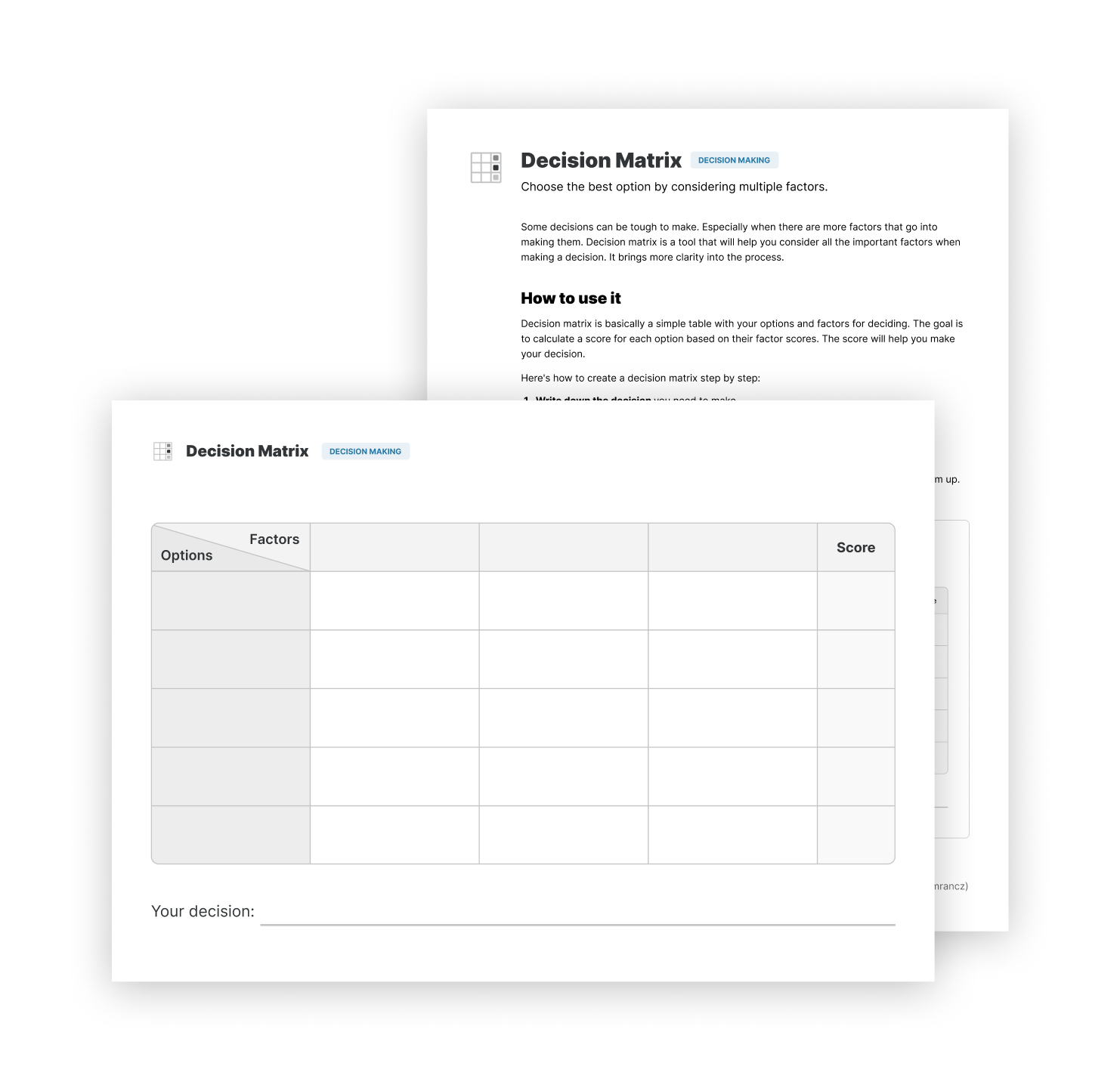Decision matrix
DECISION MAKINGSome decisions can be tough to make. Especially when there are more factors that go into making them. Decision matrix is a tool that will help you consider all the important factors when making a decision. It brings more clarity into the process.
It is most useful when you have several options and you need to decide between them based on a number of different factors.
How to use it
Decision matrix is basically a simple table with your options and factors for deciding. The goal is to calculate a score for each option based on their factor scores. The score will help you make your decision.
Here's how to create a decision matrix step by step:
- Write down the decision you need to make
- List the options you have
- Identify factors that you want to consider
- Score the options on each factor
- Add weight to the factors
- Calculate the options' scores – multiply each score by the factor weight, then add them up.
- Pick your winner – option with the highest score
Let's see how this works in practice.
Practical example
Suppose you're leading a design team and you want to decide which design tool you want to use as a team. You've done some research and you narrowed down your options to three: Sketch, Figma and Framer. Let's put them in your decision matrix table.
| Factors | TBD | TBD | TBD | Score |
| Weights | ||||
| Sketch | ||||
| Figma | ||||
| Framer |
Now let's look at the factors you need to consider. You have a set budget for tools so cost will be the first factor. After discussing with your team, you agree that prototyping and collaboration capabilities of a tool are most important for them. Now you have the factors that will influence the decision.
| Factors | Cost | Prototyping | Collaboration | Score |
| Weights | ||||
| Sketch | ||||
| Figma | ||||
| Framer |
It's time to score each option on every factor. Let's use a scale of 1 to 5 (where 1 is the worst, 5 is the best), but you can use any scale you like.
Cost – You find out that Figma and Framer both cost $12/editor/month, while Sketch is a little cheaper at $9. You'll score them 3 and 4 respectively.
Prototyping – Framer comes out as the most powerful in prototyping. Figma and Sketch are somewhat similar, but Figma can do a little more. Framer gets a 5, Figma a 3 and Sketch a 2.
Collaboration – You let your team evaluate this one. They agree that Figma is the best for collaboration, scoring it with 5. Sketch and Framer both get a 3.
Let's see how these look like in your decision matrix:
| Factors | Cost | Prototyping | Collaboration | Score |
| Weights | ||||
| Sketch | 4 | 2 | 3 | |
| Figma | 3 | 3 | 5 | |
| Framer | 3 | 5 | 3 |
At this point, the decision might be a little clearer, but all factors aren't equally important. You need to add weight to them. Since your budget is set, the cost factor is the most important, making it a 5. Your team says that prototyping is a little more important for them than collaboration features. You weight the factors accordingly:
| Factors | Cost | Prototyping | Collaboration | Score |
| Weights | 5 | 4 | 3 | |
| Sketch | 4 | 2 | 3 | |
| Figma | 3 | 3 | 5 | |
| Framer | 3 | 5 | 3 |
The next step is multiplying the scores with the weight of each factor. Score on each factor then adds up to a final score for every option:
| Factors | Cost | Prototyping | Collaboration | Score |
| Weights | 5 | 4 | 3 | |
| Sketch | 4*5 = 20 | 2*4 = 8 | 3*3 = 9 | 37 |
| Figma | 3*5 = 15 | 3*4 = 12 | 5*3 = 15 | 42 |
| Framer | 3*5 = 15 | 5*4 = 20 | 3*3 = 9 | 44 |
And there you have it. You have a score for each option based on the factors that are important for you. In this case, Framer comes out as the winner.
Decision matrix is a very useful tool for situations like this. When there are multiple factors to consider, this tools removes the uncertainty and subjectivity from your decision-making. It allows you to clearly figure out which decision is the most reasonable to make.
Put this tool to practice
I've created a template (in PDF and Miro) for applying Decision matrix in practice. It includes a step-by-step reference guide with an example.
You can get it with Untools Vault which gives you instant access to all Untools premium templates and monthly exclusive deep-dives about thinking tools.
Preview of the template and guide:
